Invasive Species: Centaurea calcitrapa, Purple Starthistle
Purple starthistle is a biennial to perennial invasive plant. It grows 2 to 3 ft. (0.6 to 0.9 m) tall. The stems and leaves are covered with fine hairs. Lower and basal leaves are divided or deeply lobed. Leaves become less divided toward the apex of the plant. Flowering occurs from July to October, when purple to pink blooms develop at the ends of the stems. Floral bracts are tipped with 1 in. (2.5 cm) long, straw-colored spines. Fruit are achenes that are about 1/8 in. (2.5 to 3.5 mm) long; white or brown streaked; and smooth without a pappus. A native of southern Europe, purple starthistle produces prolific seeds and often invades floodplains, dry forests, and grasslands. This plant is common in many western states and may occasionally be found in some midwestern and mid-Atlantic states.
What are invasive species and why should we be concerned about them?
Taxonomy: Scientific and Common Names for This Species
Asterales > Asteraceae > Centaurea calcitrapa L.
Synonym(s): red starthistle
Centaurea calcitrapa – USDA PLANTS Profile
Distribution Maps
Purple starthistle – The reported distribution of this invasive species across the United States. (Source: Invasive Plant Atlas of the United States)
Up-to-the-minute distribution maps and why they are important
Reporting This Invasive Species
What is the best way and place to report the occurrence of an invasive species?
How to report an invasive species sighting to EDDMapS – Early Detection & Distribution Mapping System
EDDMapS – Report an invasive species to EDDMapS
Cooperative Extension Offices – Find your local Cooperative Extension Office on this map provided by USDA
How to Identify
This invasive species can be identified by looking for the characteristics described in the paragraphs that follow.
Plant
Purple starthistle is a biennial to invasive perennial plant that grows 2 to 3 ft. (0.6 to 0.9 m) tall. The stems are covered with fine hairs.
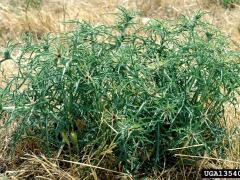 |
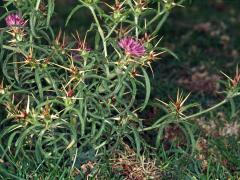 |
| Barry Rice, sarracenia.com, bugwood.org | Malcolm Storey, BioImages – Virtual Field-Guide, bugwood.org |
Foliage
Lower and basal leaves are divided or deeply lobed. Leaves become less divided toward the apex of the plant. The leaves are covered with fine hairs.
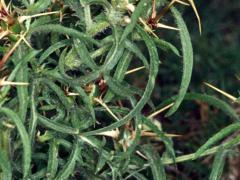 |
 |
| Malcolm Storey, BioImages – Virtual Field-Guide, bugwood.org | Steve Dewey, Utah State University, bugwood.org |
Flower
Flowering occurs from July to October, when purple to pink blooms develop at the ends of the stems. Floral bracts are tipped with 1 in. (2.5 cm) long, straw-colored spines.
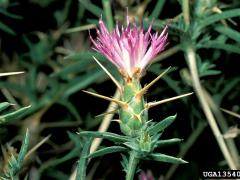 |
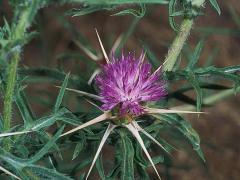 |
| Barry Rice, sarracenia.com, bugwood.org | Joseph M. DiTomaso, University of California – Davis, bugwood.org |
Fruit
Fruit are achenes that are about 1/8 in. (2.5-3.5 mm) long; white or brown streaked; and smooth without a pappus.
 |
 |
| Barry Rice, sarracenia.com, bugwood.org | D. Walters and C. Southwick, CPHST, bugwood.org |
Native Centaurea Species That Resemble Purple Starthistle
Centaurea americana, American star-thistle – Images at invasive.org
 |
 |
| Karan A. Rawlins, University of Georgia, bugwood.org | Karan A. Rawlins, University of Georgia, bugwood.org |
Vernonia gigantea, tall ironweed – Images at invasive.org
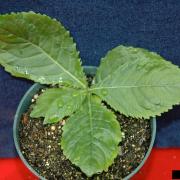 |
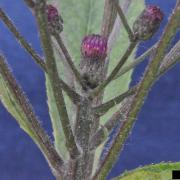 |
|
Bruce Ackley, The Ohio State University, |
Bruce Ackley, The Ohio State University, bugwood.org |
Additional Images for Purple Starthistle
Purple starthistle – Images at Invasive.org
Learning Resources for Purple Starthistle
Additional Information, Biology, Control and Management Resources
Control and management recommendations vary according to individual circumstances. Location, habitat, weather, and a variety of other conditions are factors that help determine the best treatment choice. To find the safest and most effective treatment for your situation, consult your state’s land-grant institution. If you will use chemicals as part of the control process, always refer to the product label.
Unied States Land-Grant University System – Find your land-grant university’s College of Agriculture, Cooperative Extension Service, or other related partner on this map provided by USDA.
Plant Profiles – Cal-IPC
Noxious Weeds – King County
Invasive Plant Management – Cal-IPC
Noxious Weed Control – ODA Plant Division
Invasive.org – Center for Invasive Species and Ecosystem Health
Jepson Herbarium – University of California
